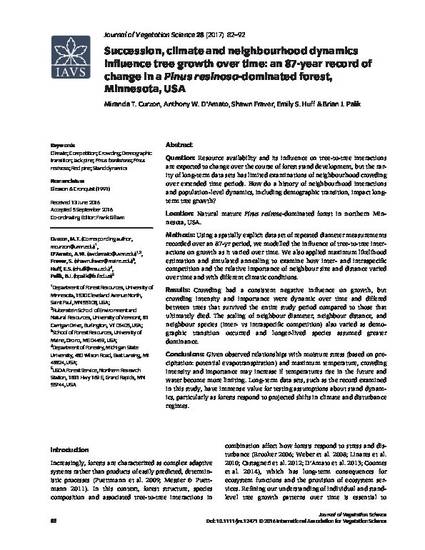
Article
Succession, climate and neighbourhood dynamics influence tree growth over time: an 87-year record of change in a Pinus resinosa-dominated forest, Minnesota, USA
Journal of Vegetation Science
(2016)
Abstract
Question: Resource availability and its influence on tree-to-tree interactions are expected to change over the course of forest stand development, but the rarity of long-term data sets has limited examinations of neighbourhood crowding over extended time periods. How do a history of neighbourhood interactions
and population-level dynamics, including demographic transition, impact long term tree growth?
Location: Natural mature Pinus resinosa-dominated forest in northern Minnesota, USA.
Methods: Using a spatially explicit data set of repeated diameter measurements recorded over an 87-yr period, we modelled the influence of tree-to-tree interactions on growth as it varied over time. We also applied maximum likelihood estimation and simulated annealing to examine how inter- and intraspecific competition and the relative importance of neighbour size and distance varied over time and with different climatic conditions.
Results: Crowding had a consistent negative influence on growth, but crowding intensity and importance were dynamic over time and differed between trees that survived the entire study period compared to those that
ultimately died. The scaling of neighbour diameter, neighbour distance, and neighbour species (inter- vs intraspecific competition) also varied as demographic transition occurred and longer-lived species assumed greater dominance.
Conclusions: Given observed relationships with moisture stress (based on precipitation: potential evapotranspiration) and maximum temperature, crowding intensity and importance may increase if temperatures rise in the future and water become more limiting. Long-term data sets, such as the record examined
in this study, have immense value for testing assumptions about stand dynamics, particularly as forests respond to projected shifts in climate and disturbance regimes.
Keywords
- Climate,
- Competition,
- Crowding,
- Demographic Transition,
- Jack pine,
- Pinus banksiana,
- Pinus resinosa,
- Red pine,
- Stand dynamics
Disciplines
Publication Date
September 5, 2016
DOI
10.1111/jvs.12471
Publisher Statement
© 2016 International Association for Vegetation Science
Citation Information
Works produced by employees of the U.S. Government as part of their official duties are not copyrighted within the U.S. The content of this document is not copyrighted.
